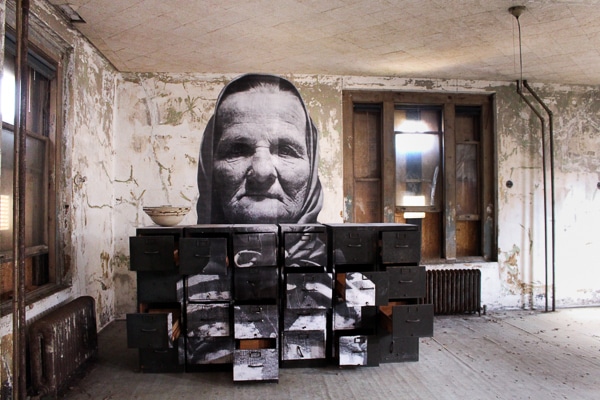
[Updated February 16, 2022] On the Ellis Island Hard Hat Tour, our guide described how, when new arrivals to New York City disembarked from their ships, doctors were present to give cursory physical assessments. Passengers had to walk up the concrete steps leading into the immigration station entrance.
If they appeared to have trouble, they were scrutinized. During the physical exam, if anything such as a fever or rash aroused suspicion of health problems, especially contagious diseases, the new arrivals were sent to the Ellis Island Immigrant Hospital for further evaluation.
Of the 12 million immigrants who passed through Ellis Island between 1892 and 1954, about 10 percent warranted a further physical exam. Once that was set in motion, a person could expect an average hospital stay of two weeks.
Some were released. Others—those diagnosed with the worst, incurable illnesses—were returned to the countries they came from. This tragic fate befell 2 percent of the millions of immigrants who had endured the sea crossing to come to the United States. They were simply sent home.
When Ellis Island closed in 1954, the Ellis Island Immigrant Hospital was shuttered. The 29-building complex became just a collection of abandoned buildings in NYC. What was found when the hospital was opened 60 years later was a time capsule of those quarantine wards that had served as a waystation for some and a place where dreams were stamped out for others.
Now, thanks to the non-profit organization Save Ellis Island, whose goal is to raise money to restore the complex, visitors can take a guided tour of the unrestored hospital buildings which, in my opinion, is one of the most unique experiences in NYC.
Read on to learn more about the tour, the art exhibition within the tour, and all the essential information you’ll need to book your trip. I’ve also included my own family connection to the old Ellis Island hospital.
Touring the Abandoned Hospital Buildings
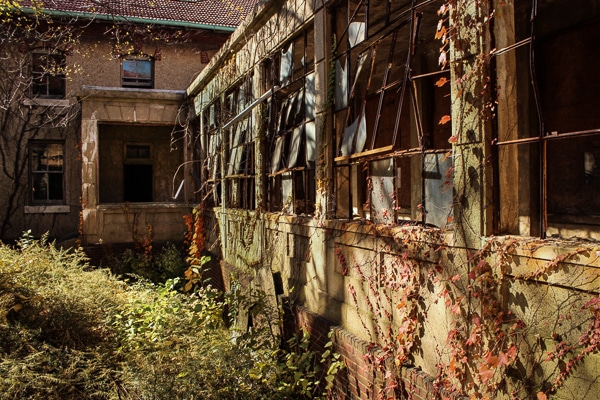
The Ellis Island Hart Hat Tour is an intriguing 90-minute history lesson that dives deeply into the experiences of the men, women, and children who left their homes behind in search of more prosperous lives. The abandoned hospital, with its long corridors lined with rusty pipes and crumbling ceilings, makes a poignant place to try and understand their stories.
Our tour began with our guide describing a timeline of Ellis Island’s waves of immigration and the physical exam new arrivals had to pass in order to be allowed into the country. Those who didn’t pass were put in the hospital and had to undergo further tests. They had to produce throat, anal, urine and stool samples, as well as blood to test for syphilis.
Based on the findings, patients were placed in quarantine wards, sometimes totally isolated depending on the ailment, perhaps for a week or maybe two.
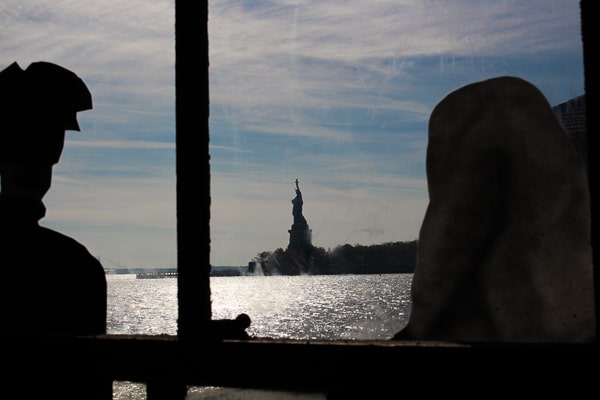
Our guide then took us into the laundry room, where the massive industrial machines were so old they were barely recognizable as laundry apparatus. Our guide described how the machines were used to regularly sanitize the clothes and mattresses of the sick and dying. An astonishing 3000 pieces of laundry came through here daily.
We toured the morgue, eerie for its cavernous concrete amphitheater-style seating and tidy-looking cupboards where cadavers were kept. Because all the world’s infectious diseases passed through Ellis Island, doctors flocked here to study them. It became a world-class teaching hospital.
Ailments such as trachoma, diphtheria, measles, hookworm, and tuberculosis were just a few of the contagious diseases that doctors studied and treated.
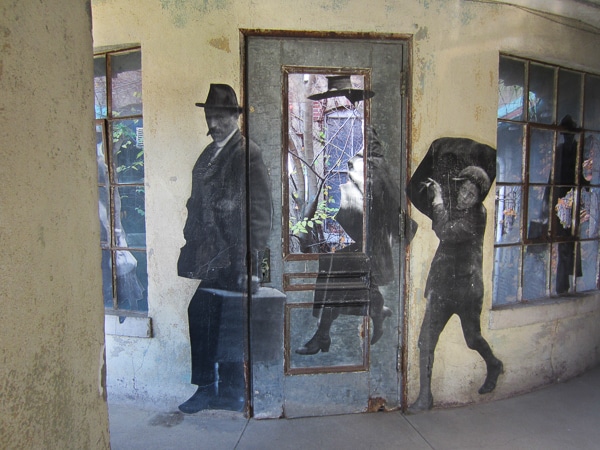
The concrete floors of the hospital, along with the entire hospital complex, are in extreme disrepair. White tiles have fallen off the walls and lay in small heaps on the floor. Doors hang off their hinges, windows are shattered. For these reasons, visitors are required to wear sturdy shoes and hard hats are handed out at the beginning of the tour. It’s crucial to watch where you walk.
Art Exhibit: Unframed – Ellis Island by artist JR
The Ellis Island Hard Hat Tour is 90 minutes of dramatic contrasts. In a gray concrete tuberculosis ward, you might look out a filthy window, through its bent and rusted iron panes, and catch a glimpse of the shimmering blue harbor and unmistakable outline of the Statue of Liberty.
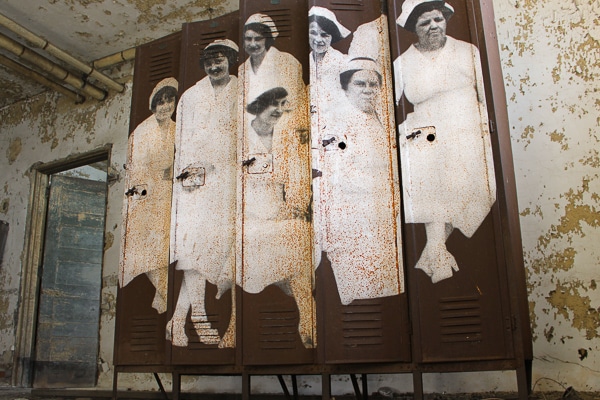
And there’s a second component that makes it even more haunting. When the Ellis Island hospital opened for tours in 2014, the French artist JR installed a site-specific art installation titled Unframed – Ellis Island throughout the wards.
For the exhibition, JR gathered photos from the Ellis Island archives and staged them—as large as life—throughout the buildings.
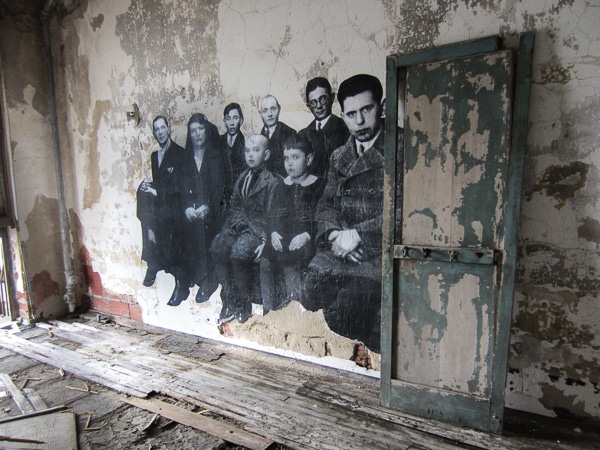
JR is a street artist known for creating projects that speak to the harsh realities of life for marginalized people, and there’s no question he addressed that here. At one point, we passed a decaying, sagging stairway that I wouldn’t trust to hold my weight. Plastered on the wall above it was a black-and-white life-sized portrait of the immigrants who actually trudged up those stairs, their faces weathered and tired, looking at the camera with grim gazes.

On each of the three Hard Hat Tours I’ve been on, the tour guides may or may not point out where to find JR’s works. You may want to ask them to point out the art, however, I loved passing by a sagging doorway or dark hallway only to unexpectedly “discover” a life-sized portrait incorporated into it seamlessly.
The most beautiful thing about the JR Ellis Island exhibit is you don’t know when the photos will appear.
My Family Connection to Ellis Island Hospital

It is now easier than ever to access records, via an online database, of the immigrants who passed through Ellis Island. Thanks to a cousin who put together a book about my family’s history, I have this information at my disposal.
I’m not sure I really appreciated it, though, until I visited Ellis Island. I’d always known I had great-grandparents who had come from Italy but I’d never sought to understand their actual lived experience.
This lack of appreciation and curiosity was common where I grew up in upstate New York. Almost everyone I knew had relatives on the branches of their family tree who’d come from Europe–specifically Italy–at some point.
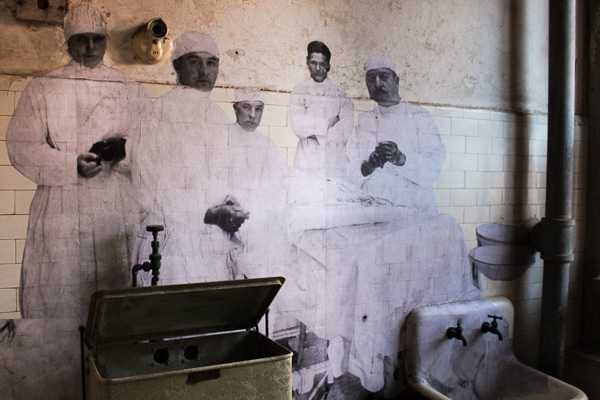
Just before I took my first Hard Hat Tour, I flipped through the book about my family’s history and found a direct connection to the immigrant hospital. For me, that connection led to a much deeper experience of the abandoned hospital tour.
When our guide led us to the infectious diseases ward, I thought of my great-great aunt Anna, whom I had read about in the family history book my cousin had put together.
Anna was four years old when she, her four older sisters, and their mother Rosa left Crotone, a coastal town in Southern Italy. They were passengers on the S.S. Calabria and in November 1912, after a three-week journey across the Atlantic Ocean, the family left the ship and stood in a queue at Ellis Island.
During a cursory physical exam, it was determined that little Anna had contracted measles on the ship so the entire family was quarantined. They slept on benches and on the cold concrete floor until Anna was well.
Anna was lucky. She was in the hospital but she was with her family. They celebrated their first Thanksgiving in quarantine, where they laughed because they thought Americans had set aside a special holiday to worship turkeys.
After five days, Anna’s quarantine was lifted. Rosa and the sisters took a train to Rome, NY, where Rosa’s husband Salvatore awaited them. Salvatore had arrived four years earlier, in 1908, and had worked and saved to bring his wife and daughters to America.
Salvatore and Rosa rented a small apartment on Lock Street in Rome. They had five more children, for a grand total of ten. On Lock Street, a pot-belly stove kept the family warm and served as a gathering point. Salvatore drank homemade wine and liked to sing loudly, while the kids told stories, played cards, and crocheted.
My great-grandmother Catherine was one of those children gathered around the stove. Along with Anna, she stepped off the S.S. Calabria in 1912. She giggled with the sisters over a culture they thought worshipped a turkey, and then grieved over little Anna five years later when Anna died of a bone disease at age nine.

The story of my family’s immigration became so much more real to me after I’d walked the chilly halls of the Ellis Island Immigrant Hospital, where they also walked, slept, and ate as they waited for Anna to recover.
When I connect the dots from Rosa, Catherine, and Anna to this very moment in time, my family history is far from abstract. My great-grandmother Catherine married a man named Leonardo. They had seven children, including my grandfather Salvatore in 1919.
These days, my grandfather walks on a treadmill every day, decks out his apartment with Christmas decorations every year, and drinks one beer on Sundays when his daughters, including my mom, come to visit.
In 2019, relatives traveled from far and wide to attend his 100th birthday party, which he threw for himself at The Savoy, his favorite Italian restaurant in Rome, NY. In March of 2023, Salvatore celebrated his 104th birthday.
I was five years old when Catherine died so I have a murky, black-and-white memory of a stout lady, her hair pulled back from her face in a stern bun. I remember her home smelled like Italian cookies and powdered sugar, a smell which has traveled through time and into my own mother’s kitchen when she bakes cookies at Christmas time. I feel deeply that it’s a gift to be able to know this history.
The history of immigration in New York City is endlessly fascinating to me, and speaks in so many ways to the history of the U.S. The Hard Hat Tour, as well as the entire Ellis Island Museum, is a place anyone interested in history should visit. It’s a tribute to the people who traveled here to begin new lives.
The Hard Hat Tour is also a bit off the beaten path for anyone searching for less touristy things to do in New York.
How to Book the Ellis Island Hard Hat Tour
The hospital complex is located on the south side of Ellis Island, separate from the Ellis Island National Museum of Immigration. You’ll receive instructions on where to meet once you book your tour. Here are the steps for booking a tour:
- Go to Statue City Cruises.
- Select Ellis Island Hard Hat Tour as your ticket option.
- Select your departure location as either New Jersey (Liberty State Park) or New York (Battery Park).
- Select your desired date, then choose a Security Check In Time. Your Security Check In Time is the time you’ll report to your departure location (Battery Park in New York or Liberty State Park in New Jersey).
- See the chart that displays your tour start-time based on your selected Security Check In Time.
- Purchase your tickets. Admission: Adults (13+): $68.50. Seniors (62+): $63.00. Look for email confirmation and e-tickets via email.

Source: cityexperiences.com
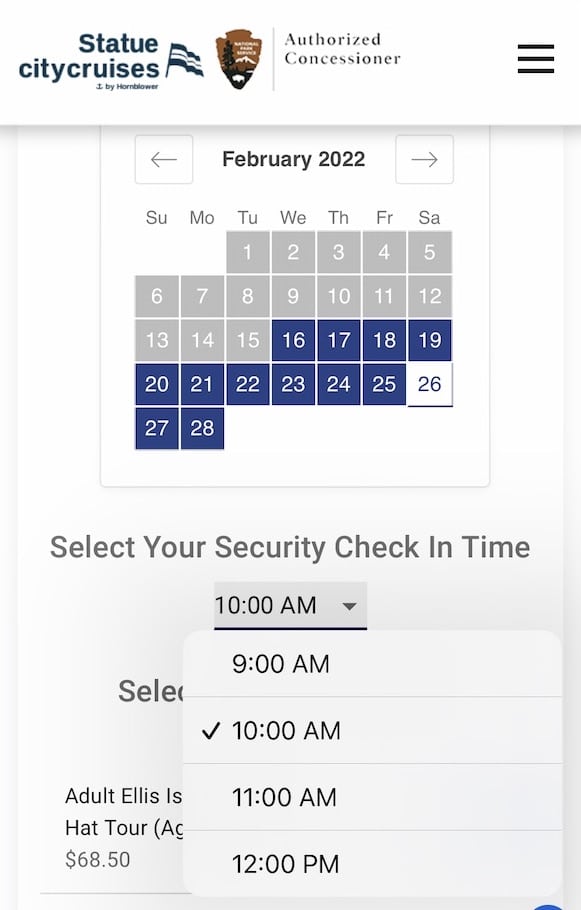
Source: cityexperiences.com
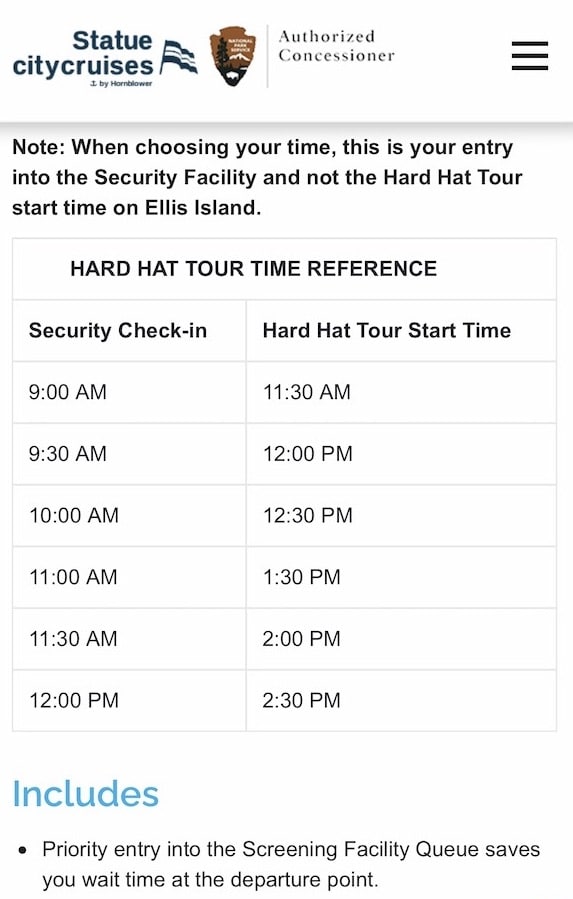
You may also book this via the City Experiences app. The steps are similar to those above though the appearance differs slightly.
In addition to the 90-minute Ellis Island Hard Hat Tour, your ticket includes:
- priority entry into the screening facility at your point of departure.
- round-trip ferry transportation from your point of departure.
- entrance to the Ellis Island National Museum of Immigration + audio tour.
- access to the grounds at Liberty Island, an audio tour, and entry to the Statue of Liberty Museum.
Note: You must purchase a separate ticket if you wish to enter the Statue of Liberty Pedestal.
How to Get to Ellis Island
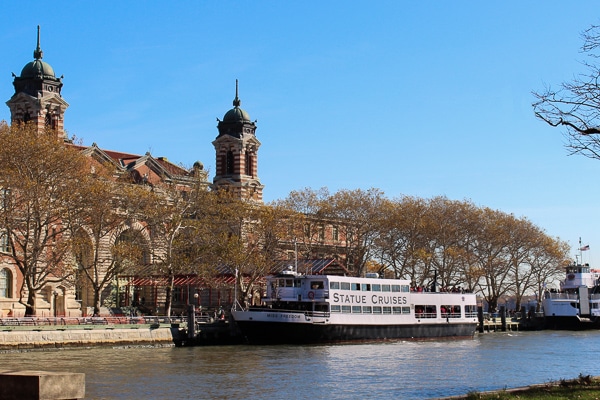
From Battery Park in New York:
- Subway to Battery Park: Take the 1 to South Ferry, the 4 or 5 to Bowling Green, or the R or W to Whitehall Street.
- Walk about 5-6 minutes to the Statue Cruises departure point. The line usually begins at Castle Clinton, which is also the Statue Cruises ticket office.
- Plan to arrive at least 30 minutes prior to the Security Check In Time you selected when you purchased your Hard Hat Tour ticket.
- Go through airport grade security.
- Ferries depart every 25-30 minutes. As long as you make it to Ellis Island by your tour start-time, you’ll be fine. It takes about 20-25 minutes for the ferry ride to Ellis Island. The first stop is Liberty Island. Do not get off here. Go to the second stop, which is Ellis Island.
From Liberty State Park in New Jersey:
- By car: Take the New Jersey Turnpike to Exit 14-B. Follow signs to Liberty State Park.
- As at Battery Park, arrive at least 30 minutes prior to the Security Check In Time you selected.
See here for more transportation options to Battery Park and Liberty State Park.
Essential Information for the Ellis Island Hard Hat Tour
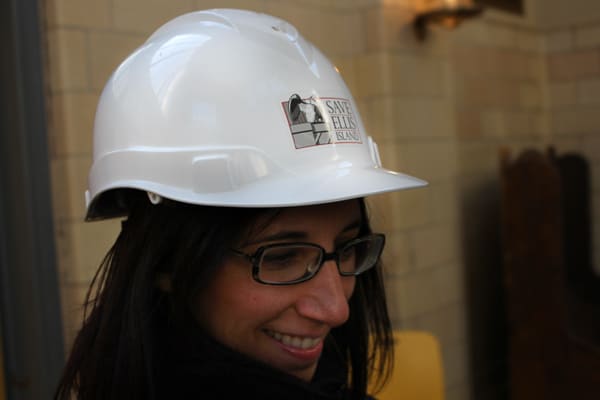
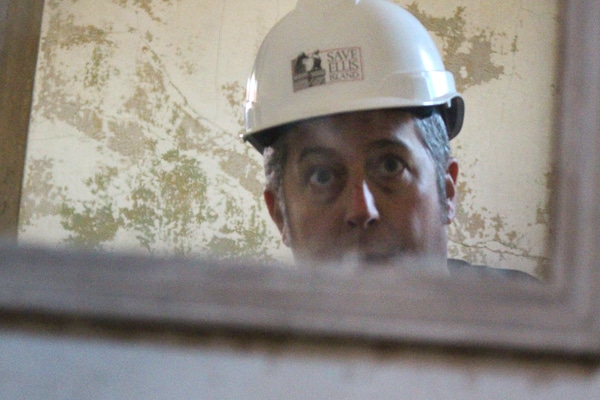
- Due to the dilapidated state of the hospital complex, the Hard Hat Tour is not ADA accessible.
- All Hard Hat Tour participants must be 13 or older. Under 18 must be accompanied parent or guardian.
- Wear sturdy comfortable shoes. The tour is 90 minutes long. There’s a lot of walking and there may be debris on the ground.
- Keep the weather in mind on the day of your tour. The abandoned buildings are not temperature controlled.
If you have any interest in history, immigration, or abandoned places, I highly recommend taking this tour. It allows you to roam actual halls where history happened and provides a sharp contrast between New York’s past and present.